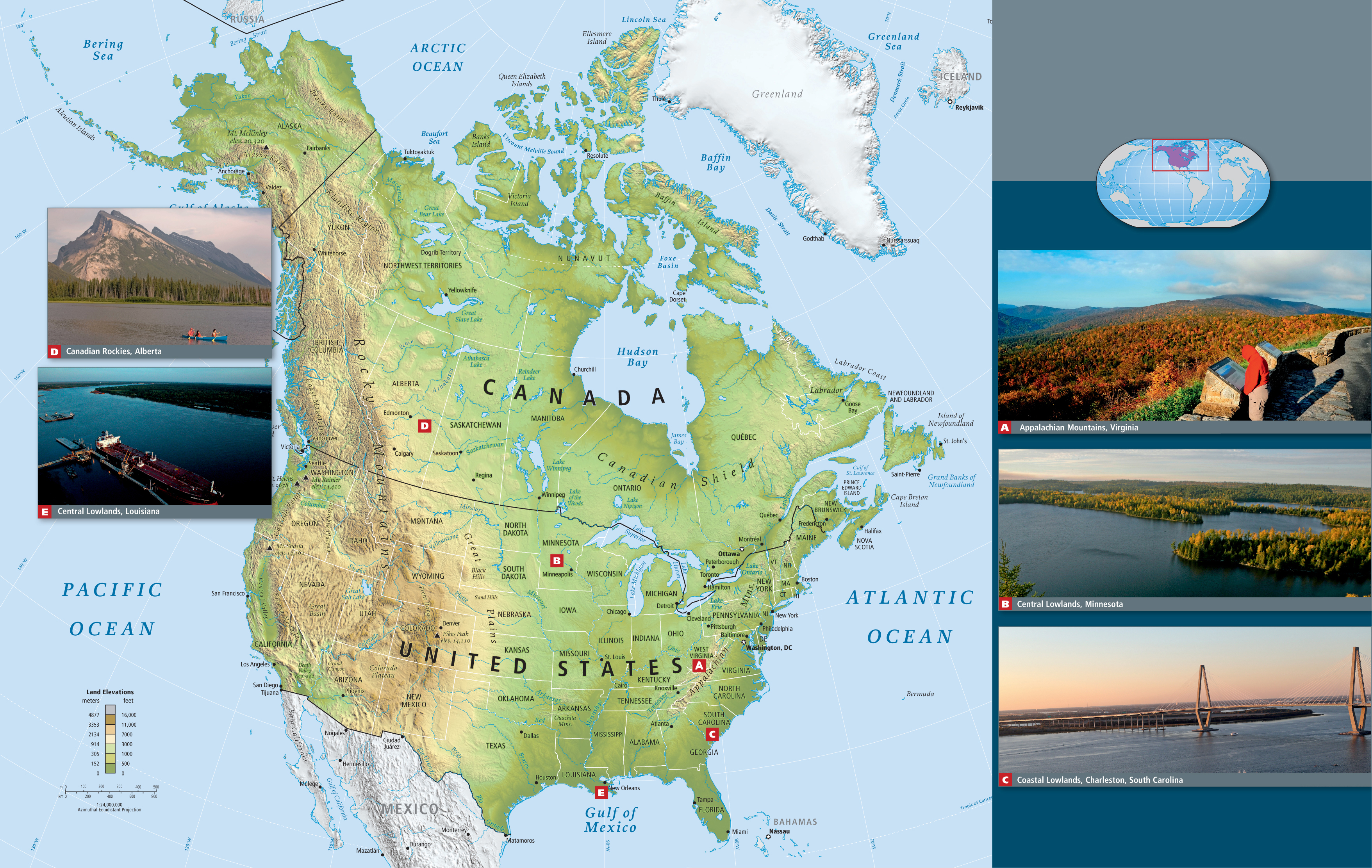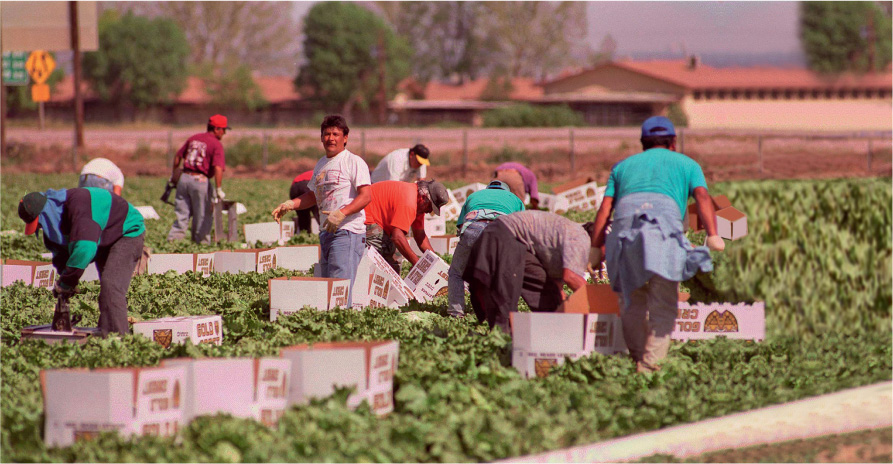2.1 2 North America

58
59
60
2.1.1 Geographic Insights: North America
Geographic Insights: North America
After you read this chapter, you will be able to discuss the following geographic insights as they relate to the nine thematic concepts:
1. Climate Change and Urbanization: North America’s large per capita production of greenhouse gases is related to its standard of living and dominant pattern of urbanization.
2. Water and Food: North American food production systems contribute to water scarcity and water pollution.
3. Power and Politics: The interpretation of the ideal of democracy by Canada and the United States has influenced North America’s involvement in the affairs of countries around the world.
4. Globalization and Development: Globalization has transformed economic development in North America, thereby changing trade relationships and the kinds of jobs available in this region.
5. Population and Gender: Side effects of changes in gender roles and in opportunities for women include some improvements in education and pay equity; smaller families; and the aging of North America’s population.
The North American Region
North America (see Figure 2.1) is one of the largest and wealthiest regions of the world. It encompasses many environments and a complex array of local cultures and economic activities that interact with each other across wide distances. The nine thematic concepts in this book are explored as they arise in the discussion of regional issues, with interactions between two or more themes featured, as in the geographic insights above. Vignettes illustrate one or more of the themes as they are experienced in individual lives.
Global Patterns, Local Lives
VIGNETTE
Javier Aguilar, a 39-year-old father of three, has worked as an agricultural laborer in California’s Central Valley for 20 years. He and hundreds of thousands like him tend the fields of crops (Figure 2.2) that feed the nation, especially during the winter months. Aguilar used to make $8.00 an hour, but now he is unemployed and standing in a church-sponsored food line. “If I don’t work, [we] don’t live. And here all the work is gone,” he says, grimly.
In Mendota, also in California’s Central Valley, young Hispanic men wait on street corners to catch a van to the fields. None come. By March of 2009, the unemployment rate in Mendota was 41 percent and rising, and Mayor Robert Silva said his community was dying on the vine. He saw the trouble spreading. Many small businesses were closing. Silva worried about drug use, alcohol abuse, family violence, and malnutrition that can accompany severe unemployment in any community.
This level of unemployment in the heart of the nation’s biggest producer of fruit, nuts, and vegetables was partly due to drought and partly to a global economic recession. The drought is related to natural dry cycles as well as global climate change. Water is increasingly scarce in the Central Valley, and access to irrigation water has been cut to force conservation. Meanwhile, the global economic recession, commencing in 2007 and continuing into 2012, reduced overall demand for California’s fresh fruits and vegetables as families turned to cheaper foods or those grown closer to home. All of these stresses have forced farmers to remove from production as much as 1 million of the 4.7 million acres once cultivated and irrigated in the Central Valley. This may eventually result in a loss of as many as 80,000 jobs and as much as $2.2 billion in California agriculture and related industries. And even though by early 2012, agricultural production in Mendota had partially revived, unemployment remained over 16 percent, nearly twice the national average.
The confluence of troubles in California’s Central Valley has been particularly devastating for low-wage Hispanic male agricultural workers like Javier Aguilar, because they have so little to fall back on in terms of savings, education, or skills. Low-wage–earning Hispanic women may be somewhat better off. They are likely to remain employed because they are in domestic and caregiving jobs for which demand is likely to increase; they also have somewhat higher levels of education. One potential silver lining in this tale is the fact that economic hardship often encourages unskilled workers like Aguilar to take advantage of government-sponsored adult education programs. His children may also have a greater opportunity than did he to graduate from high school. During the Great Depression of the 1930s, similar programs encouraged people to go back to school, causing the nation’s high school graduation rate to jump from 20 percent to 60 percent. [Source: New York Times; PBS NewsHour. For detailed source information, see Text Credit pages.]
THINGS TO REMEMBER
 The story of Javier Aguilar illustrates the complexity of the relationships between various thematic concepts—water, food, development, gender, and global climate change. Reviewing how these concepts are linked here will help you throughout the book.
The story of Javier Aguilar illustrates the complexity of the relationships between various thematic concepts—water, food, development, gender, and global climate change. Reviewing how these concepts are linked here will help you throughout the book.

Thinking Geographically
Question
ukzE9YkRf4AhqkQeVO2O4860Gfqt4rUVwWlTzKWyzcztLesvlTy1VOI79883+NNqN3Rwju4ghksp0a33t3e/Yq0PHSbdQkCE5w8muN6HjTdcMUtNvxHxGgruLpcaZx3aqQ19rNvXN6Jt6wK9GasbdpvDHiUeY90lypDChpCdhCKzIn/YLs4Rs+yc13OtnK9hJxADvWqlpFCQHbj1XClf+7jIhYEji7n3MsxUn7Ya66xUmE4vXGK+ES/o3Ed0iQ9QVDGwyb1cc+UCHSLaXUZbWv3MjE4MWQxN2e7U1bBvoiQnJL/gESRJiRkJXthu+4NgN9Iuo8m0jUCjWYUS/XY/VmK+VDwMTTlBeOsVc0oJRAp3+d2TLE7CEE4RXhyNXn43/GLklPYx7j2xCa7xkErn8oIzhMD/BuvuaAduOHXKk7fkfgseAL/UYwNYh9VcZtiNsNCNUsTqRM0k6qsJPH9bQXgBDQDjRhUxJDo4MGLudRAGudmKfwLl2OOmVXvoe6Nvt54H91GZGmvr0RM/OBDFJa24WGSGK1CJor7Xs1AnR64+ng+dLZ/LVQCTywmiyPqRBlAe4v2DS3A=61